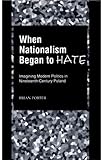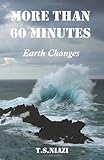
Average Reviews:

(More customer reviews)"When Nationalism Began to Hate" is an excellent book. The title is a bit sensationalistic and a bit misleading.
WNBtH is a history of eighteenth century Polish nationalism. It is an attempt to answer the question: Why is it that decent Poles, and certainly decent Polish Catholics, in the 1880s, could not and did not publicly support an anti-Semitic brand of nationalism, and yet by the 1930s, this had changed -- Polish Nationalism and Polish Catholicism were both often openly anti-Semitic?
What happened?
Porter takes the reader on a journey through the tragedies of Polish history, and the uprisings that Poles mounted to resist German and Russian colonizers' attempts to eliminate Polish identity, and the theorizing that went on behind these uprisings.
Philo-Semitism was a marked feature of Polish Romantic nationalism, and Jews did participate in the struggle for Polish freedom. Many Poles saw Jews as an integral part of Poland. Mickiewicz created Jankiel, a Polish Jewish hero of the national epic, "Pan Tadeusz." Patriotic Jewish Poles were not just a feature of fiction; Jews like Michal Landy gave their lives in the nationalist struggle.
A feature of Mickiewicz's Romantic Nationalism was the concept of Poland as the "Christ of Nations," that would struggle for the uplift of all humanity. This wasn't just rhetoric -- Poles fought internationally. Poles like Haym Solomon, Tadeusz Kosciuszko, and Casimir Pulaski contributed to the American Revolution in this multi-national, Christian-inspired spirit.
Poland's many uprisings against Russian and German colonizers ended tragically, with the deaths and deportation of many, and even harsher attempts to stamp out Polish language and culture.
These tragedies changed Polish nationalists' views of time -- could time really result in progress? -- and what constituted a Pole. Could Lithuanians, Belorussians, Ukrainians, and Jews ever be part of a successful Polish nation state?
Peasants presented a particular problem. A popular argument stated that Polish uprisings failed because the peasants did not support them, and, in fact, had no reason to. Did it matter to them if they slaved for Poles, Austrians, or Russians? What did peasants care about Poland's literary heritage? They couldn't read. Some regarded peasants as inherently lesser creatures, perhaps inferior because of reincarnation.
Similar questions were asked about Jews and other ethnic minorities.
The answers that Poles, struggling with a highly multi-cultural, multi-faith population, came up with are fascinating, and speak to the mult-cultural, multi-faith world many of us live in today. One can hear echoes on nightly news discussions of how to address Spanish speaking, or Muslim, immigrants to the US.
Porter emphasizes that there is nothing inherently Polish, or Catholic, or Polish-Catholic, about anti-Semitism. Anti-Semitism was a development of one train of nationalist thought, a train of thought inspired by Social Darwinism and Scientific Racism.
Roman Dmowski, the proponent of this train of thought, wrote with brutality about forcing nationalism on peasants, whether they liked it or not, and forcing deportation on Poland's Jews. Dmowski stated, "Every Pole should be the enemy of every German he meets."
Dmowski had suffered under colonization, and he was a trained biologist. He was influenced by Social Darwinism, and saw life as a struggle for the survival of the fittest. He wanted Poles, as he understood Poles, to survive.
Dmowski rejected Poland's Romantic Nationalism, as embodied by Mickiewicz, and Mickiewicz's multicultural, philo-Semitic view of Poland. That approach -- the Romantic approach -- was worthlessly "spiritual" in Dmowski's view, and doomed to failure. Poles and Poland needed to enter the Darwinian struggle for life, and renounce any touchy-feely notions of solidarity with others who were not ethnic Poles.
Again, though this is a scholarly book, it is a fasciating read. Porter writes well. The questions the book engages are questions we are all contemplating in our increasingly globalized world.
I wish I could place "When Nationalism Began to Hate" on the required reading list of all of those who read a book that made a very big splash recently, Jan Tomasz Gross' "Neighbors."
Though I'm sure Gross did not intend this, "Neighbors," and the flood of media that accompanied its release, encouraged the stereotype of Poles as mindless, inherently anti-Semitic, brutes.
As WNBtH shows, multi-cultural societies present a series of challenges, and that is especially true when multi-cultural societies face the added stress of foreign occupation, colonization, and attempts at the elmination of the culture being colonized.
Polish thinkers developed varied ways of dealing with their oppression, and of responding to multi-culturalism. Their words, written a century ago, have resonance for us today.
Click Here to see more reviews about:
When Nationalism Began to Hate: Imagining Modern Politics in Nineteenth-Century PolandIn When Nationalism Began to Hate, Brian Porter offers a challenging new explanation for the emergence of xenophobic, authoritarian nationalism in Europe. He begins by examining the common assumption that nationalist movements by nature draw lines of inclusion and exclusion around social groups, establishing authority and hierarchy among "one's own" and antagonism towards "others." Porter argues instead that the penetration of communal hatred and social discipline into the rhetoric of nationalism must be explained, not merely assumed.Porter focuses on nineteenth-century Poland, tracing the transformation of revolutionary patriotism into a violent anti-Semitic ideology. Instead of deterministically attributing this change to the "forces of modernization," Porter demonstrates that the language of hatred and discipline was central to the way "modernity" itself was perceived by fin-de-siecle intellectuals.The book is based on a wide variety of sources, including political speeches and posters, newspaper articles and editorials, underground brochures, published and unpublished memoirs, personal letters, and nineteenth-century books on history, sociology, and politics. It embeds nationalism within a much broader framework, showing how the concept of "the nation" played a role in liberal, conservative, socialist, and populist thought.When Nationalism Began to Hate is not only a detailed history of Polish nationalism but also an ambitious study of how the term "nation" functioned within the political imagination of "modernity." It will prove an important text for a wide range of students and researchers of European history and politics.
 Get 37% OFF
Get 37% OFF
Click here for more information about When Nationalism Began to Hate: Imagining Modern Politics in Nineteenth-Century Poland





















